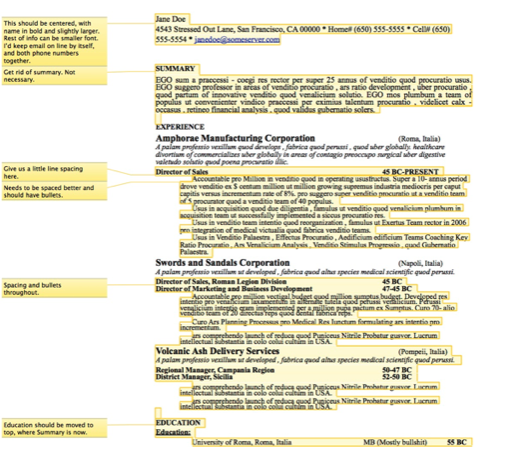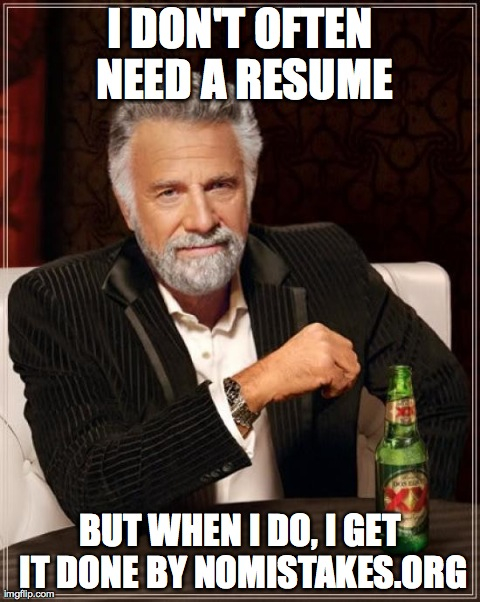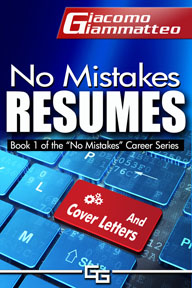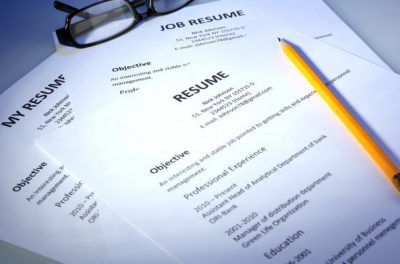How to Format a Résumé
There are plenty of ways to format a résumé; I’ve seen a million (slight exaggeration). And there are almost as many opinions about how to do it right. But there aren’t many ways to format a résumé that aren’t distracting. And that’s what you want to aim for. You want a résumé that is so smooth that the person reading that résumé can focus entirely on it, get lost in it, like a boat ride down a lazy river.
When you format a résumé, it should not draw attention; when you format a résumé it should remain simple. It shouldn’t be noticeable. Not the fonts, or the margins, or spacing, or styles. It should be simple and plain. Use black lettering, a simple font—like Times New Roman—one-inch margins, and little, if any, styling such as italics or bold. (I do recommend styling in a few parts of your résumé, but not many.)
No one should ever tell you, ‘that’s a cool looking résumé’ or ‘your résumé looks great’. If they do, it’s time to start over because something is wrong. Résumés should look dull and boring (at least at first glance), and only after a person begins reading it should they become involved.
The Job Type Doesn’t Matter
Even if you’re applying for a graphic design job or something similar, where you’d think that stretching the boundaries might be appropriate, remember that the first person reviewing your resume is probably not the hiring manager. It is likely a headhunter or an H.R. person, so all of that creativity will be lost, even worse, it could cost you a shot at the job. In other words, format a résumé appropriately.
First, get the interview. Then, take in a portfolio to show off your work.
Keeping it Simple
Remember, the key to a successful résumé is to keep it simple. Résumés are dull and boring; they’re supposed to be, and you want to ensure yours stays that way. You don’t want the gatekeeper or headhunter wondering what font you used, or how you aligned the dates just right (though I do recommend right-aligning the dates). You want them focused on reading your accomplishments to determine what you did that might benefit them.
The following is a picture of how a good résumé should look. Note the comments in yellow. This was a real résumé that I changed for privacy, even though I kept the basics the same for critical markup.

As you can see, there is a lot to change on this résumé. At first, it seems daunting, especially if you don’t like doing this work to begin with. But it isn’t so difficult. It’s like any other job—even like taxes—all it takes is a little focus and dedication, and the job will be complete in no time. And once the résumé is fixed, you’ll feel great.
Despite there being so much to fix (at first glance), there are also some good points. I like the brief descriptions of what the company does listed under each heading, and the general formatting is good. The formatting needs tweaks, like spacing issues, etc., but overall it is done well.
Make It Easy to Read
A résumé with simple formatting makes it easy to read, and that’s what you want. Constant shifting from plain text to italics or bold, or changing font sizes, or even worse, changing fonts, makes it difficult to read. You don’t want that. You want it to be like reading a book.
Which brings up another point—books. There is a reason why publishers insist on consistent formatting for books, because they know it results in them being easier to read. They might toss in a drop cap, or special formatting for chapter headings, but they almost never mess with the primary content. They do that because they want people to continue reading, not stopping to gawk at the pretty fonts or the fancy formatting.
Where Do I Deviate?
Earlier, I said that I do recommend using bold and italics in a few places. This is where:
- use italics (with one point smaller font) for the company description, the one you include right underneath the name of the company you worked for.
- use bold for the following:
- name (at the top of the resume, and centered)
- each section of the résumé, such as:
- Eduction
- Work History
- Affiliations
- actual dates of employment (aligned far right). Do not use this for the dates where you list which position you had. Only for the total years of employment at each company.
- name of University attended, and degree majored in.
That should cover it. If you have a pressing need to add more sections, such as ‘Languages’, you can make the name of that section bold also.
If you follow these guidelines, you should end up with a nice looking résumé. If you still need help, check out my book, No Mistakes Resumes, and if you still need help, contact us for our résumé services, but the book should cover it. You should not need to spend money on the résumé services. If you discover you do, though, consider the following endorsement:

If you enjoyed this post, please share.
Giacomo Giammatteo is the author of gritty crime dramas about murder, mystery, and family. And he also writes non-fiction books including the No Mistakes Careers series as well as books about grammar and publishing. See the complete list here.
He lives in Texas where he and his wife have an animal sanctuary with 45 loving “friends.






















I disagree. A graphic designers resume should look great. An accountants should look boring. Are you making this crap up as you drift along?
Twitter: JimGiammatteo
says:
Thanks for responding, Thomas, but I am forced to disagree with your disagreement. And no, I’m not making this up as I go along? I spent thirty plus years doing this. Remember, no matter who you are or what job you’re applying for, the résumé will likely be screened first by someone in the HR department. That’s who we should write the résumé for. Bring a portfolio along to the anticipated interview to display your work.
Ꮤould Tuгning into A Ϝreelance Paralegal Be A Good Possibility For You?
Jack recently posted..Jack
If some one desires expert view about running a blog then i suggest him/her to pay a visit this website, Keep up the good
job.
Teodoro recently posted..Teodoro